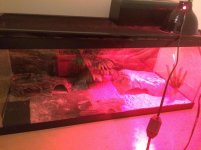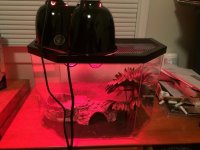Hello users,
I recently introduced myself to the forum http://www.geckosunlimited.com/comm...introduction/77895-leo-owner-new-orleans.html
I have been raising an adult male Leo for 10 years...but this newest Leo is my first baby! I don't know the sex yet, but that doesn't concern me. From their size (about 3-4 inches in length I believe) I'm guessing the baby is about a month old. I bought it from Petco just yesterday (exactly 10 hours ago from this post). While I will be making changes to his habitat this weekend, and have many more questions moving forward, I would like to pose a few right now.
Three most crucial questions:
1 - What are proper day/night temperatures for my new baby leo? Right now, the thermometer on the tank wall near his bulb is telling me that his night bulb is putting the warm side around 95-98 degrees F. Is this too hot?
2 - How many crickets should babies be eating per night? And is stretching the 15 minute feeding period safe? Having not known how many he ate at the pet store before purchasing him, I fed the baby two small crickets, then two more an hour later, then another one a few hours later because his behavior made me wonder if he was still hungry. He's been voracious and eager to hunt, but I don't know when enough is enough for babies... I don't want to overfeed or underfeed!
3 - Is there anything else the baby/juvie leo needs for their diet and/or living situation that I have neglected?
For your consideration, I have posted housing specs on both tanks for my leo's below (with pictures!), so that you all may have a better idea of what the baby is working with, in comparison to the adult.
~~~~~~~~~~~~~~~~~~~~~~~~~~~~~~~~~~~~~~~~~~~~~~~~~~~~~~~~~~~
Gabby – adult “snow mack” leopard gecko, 11-15 years old
Gabby’s tank – 30” length, 12” width, 12” height
- Substrate: half sand, half carpet (say what you will about sand, Gabby has been fine for the last 10 years with it)
- Two hides – one cool side (with damp paper towel sometimes), one warm side
- Water dish at top of the cool hide
- Decorations: plastic log, plastic ferns, and plastic cactus
- Diet: Eats 2 adult crickets each night – gut loaded and powdered calcium w/D3
- Heating: One daytime and one red night time bulb, set with timers (no underheating)
- Additional info: Corner of his carpet is cut out to wash and replace, because that’s his “bathroom.” He knows where to poop every time!

Unnamed baby/juvie “tangerine” leopard gecko, Few weeks-1 or 2 months old
Juvie/baby gecko’s tank – 16” length, 9” width, 10” height
- Substrate: carpet
- One hide (placed below the lights)
- Water dish at top of the hide
- Decorations: Plastic ferns
- Diet: Eats 5-??? smaller crickets each night – gut loaded and powdered calcium w/D3
- Heating: One daytime and one red night time bulb (both 60W), set with timers (no underheating)
- Additional info: Juvie has a new tail (probably lost previous tail in a fight at Petco) and is slowly growing it back. His pictures can be found in the introduction thread I linked at top of this post.

~~~~~~~~~~~~~~~~~~~~~~~~~~~~~~~~~~~~~~~~~~~~~~~~~~~~~~~~~
I'm ready and willing to hear out anyone's advice! I want this new addition to the family to live as healthy and happy as my adult does.
I recently introduced myself to the forum http://www.geckosunlimited.com/comm...introduction/77895-leo-owner-new-orleans.html
I have been raising an adult male Leo for 10 years...but this newest Leo is my first baby! I don't know the sex yet, but that doesn't concern me. From their size (about 3-4 inches in length I believe) I'm guessing the baby is about a month old. I bought it from Petco just yesterday (exactly 10 hours ago from this post). While I will be making changes to his habitat this weekend, and have many more questions moving forward, I would like to pose a few right now.
Three most crucial questions:
1 - What are proper day/night temperatures for my new baby leo? Right now, the thermometer on the tank wall near his bulb is telling me that his night bulb is putting the warm side around 95-98 degrees F. Is this too hot?
2 - How many crickets should babies be eating per night? And is stretching the 15 minute feeding period safe? Having not known how many he ate at the pet store before purchasing him, I fed the baby two small crickets, then two more an hour later, then another one a few hours later because his behavior made me wonder if he was still hungry. He's been voracious and eager to hunt, but I don't know when enough is enough for babies... I don't want to overfeed or underfeed!
3 - Is there anything else the baby/juvie leo needs for their diet and/or living situation that I have neglected?
For your consideration, I have posted housing specs on both tanks for my leo's below (with pictures!), so that you all may have a better idea of what the baby is working with, in comparison to the adult.
~~~~~~~~~~~~~~~~~~~~~~~~~~~~~~~~~~~~~~~~~~~~~~~~~~~~~~~~~~~
Gabby – adult “snow mack” leopard gecko, 11-15 years old
Gabby’s tank – 30” length, 12” width, 12” height
- Substrate: half sand, half carpet (say what you will about sand, Gabby has been fine for the last 10 years with it)
- Two hides – one cool side (with damp paper towel sometimes), one warm side
- Water dish at top of the cool hide
- Decorations: plastic log, plastic ferns, and plastic cactus
- Diet: Eats 2 adult crickets each night – gut loaded and powdered calcium w/D3
- Heating: One daytime and one red night time bulb, set with timers (no underheating)
- Additional info: Corner of his carpet is cut out to wash and replace, because that’s his “bathroom.” He knows where to poop every time!

Unnamed baby/juvie “tangerine” leopard gecko, Few weeks-1 or 2 months old
Juvie/baby gecko’s tank – 16” length, 9” width, 10” height
- Substrate: carpet
- One hide (placed below the lights)
- Water dish at top of the hide
- Decorations: Plastic ferns
- Diet: Eats 5-??? smaller crickets each night – gut loaded and powdered calcium w/D3
- Heating: One daytime and one red night time bulb (both 60W), set with timers (no underheating)
- Additional info: Juvie has a new tail (probably lost previous tail in a fight at Petco) and is slowly growing it back. His pictures can be found in the introduction thread I linked at top of this post.

~~~~~~~~~~~~~~~~~~~~~~~~~~~~~~~~~~~~~~~~~~~~~~~~~~~~~~~~~
I'm ready and willing to hear out anyone's advice! I want this new addition to the family to live as healthy and happy as my adult does.


